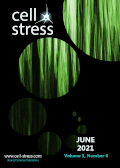Table of contents
Volume 5, Issue 6, pp. 76 - 88, June 2021
The evolution of the concept of stress and the framework of the stress system
Siyu Lu, Fang Wei and Guolin Li
Reviews |
page 76-85 | 10.15698/cst2021.06.250 | Full text | PDF |
Abstract
Stress is a central concept in biology and has now been widely used in psychological, physiological, social, and even environmental fields. However, the concept of stress was cross-utilized to refer to different elements of the stress system including stressful stimulus, stressor, stress response, and stress effect. Here, we summarized the evolution of the concept of stress and the framework of the stress system. We find although the concept of stress is developed from Selye’s “general adaptation syndrome”, it has now expanded and evolved significantly. Stress is now defined as a state of homeostasis being challenged, including both system stress and local stress. A specific stressor may potentially bring about specific local stress, while the intensity of stress beyond a threshold may commonly activate the hypothalamic-pituitary-adrenal axis and result in a systematic stress response. The framework of the stress system indicates that stress includes three types: sustress (inadequate stress), eustress (good stress), and distress (bad stress). Both sustress and distress might impair normal physiological functions and even lead to pathological conditions, while eustress might benefit health through hormesis-induced optimization of homeostasis. Therefore, an optimal stress level is essential for building biological shields to guarantee normal life processes.
Ribosome traffic jam in neurodegeneration: decoding hurdles in Huntington disease
Srinivasa Subramaniam
Microreviews |
page 86-88 | 10.15698/cst2021.06.251 | Full text | PDF |
Abstract
A ribosome typically moves at a particular rate on a given mRNA transcript to decode the nucleic acid information required to synthesize proteins. The speed and directionality of the ribosome movements during mRNA translation are determined by the mRNA sequence and structure and by various decoding factors. However, the molecular mechanisms of this remarkable movement during protein synthesis, or its relevance in brain disorders, remain unknown. Recent studies have indicated that defects in protein synthesis occur in various neurodegenerative diseases, but the mechanistic details are unclear. This is a major problem because identifying the factors that determine protein synthesis defects may offer new avenues for developing therapeutic remedies for currently incurable diseases like neurodegenerative disorders. Based on our recent study (Eshraghi et al., Nat Commun 12(1):1461; doi: 10.1038/s41467-021-21637-y), this short commentary will review the mechanistic understanding of Huntingtin (HTT)-mediated ribosome stalling indicating that central defects in protein synthesis in Huntington disease (HD) are orchestrated by jamming of ribosomes on mRNA transcripts.



